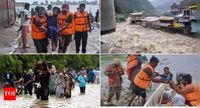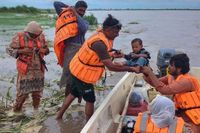More than 150,000 people have been forced to abandon their homes in Pakistan’s Punjab province after India released water from overflowing dams into already swollen border rivers, sparking fears of catastrophic flooding across one of South Asia’s most vital agricultural regions. The evacuations, confirmed by Pakistan’s National Disaster Management Authority (NDMA) on Tuesday, August 26, 2025, come on the heels of weeks of relentless monsoon rains that have battered both countries, leaving over 800 dead in Pakistan and dozens more in Indian-administered Kashmir.
The crisis began to unfold late last week when Indian officials, citing intense rainfall on their side of the border, issued a rare diplomatic warning to Islamabad. According to Reuters, the warning, delivered through diplomatic channels rather than the usual Indus Waters Commission, marked the first direct public contact between the nuclear-armed neighbors in months. The move was prompted by rising water levels at key Indian dams, notably the Madhopur and Thein dams, both of which were nearing capacity. Satellite imagery revealed the Thein Dam was 97% full, raising the specter of imminent discharges into the cross-border Ravi, Sutlej, and Chenab rivers.
Pakistan’s NDMA quickly issued its own alerts, warning of medium to high flooding along these rivers and urging residents in low-lying districts to evacuate. The response was swift but daunting: hundreds of villages along the embankments were cleared, with the army assisting in rescue operations. Relief camps sprang up in affected districts like Kasur and Bahawalnagar, where, as The Independent reported, more than 14,000 people were moved from Kasur and over 89,000 from Bahawalnagar alone.
“The flood situation is grave. The next 48 hours will be critical,” said Irfan Ali Kathia, a senior official in Punjab province, speaking to Reuters. The NDMA echoed these concerns, urging citizens to stay away from rivers and to heed alerts delivered via mobile phones and disaster apps. Despite these efforts, the sheer scale of the disaster has left resources stretched thin. Deputy commissioner Saba Asghar Ali, after visiting Pasrur city near the Indian border, assured the public, “Arrangements for food, medicines, washrooms, and other necessities have been made in relief camps.”
The humanitarian toll has been staggering. Since late June, more than 800 people have died in Pakistan due to flooding, with half those deaths occurring in August alone, according to Reuters and the NDMA. In Indian-administered Kashmir, at least 65 have perished, while flash floods in Buner district earlier this month killed more than 300 people in northwest Pakistan. Residents there complained of little warning before the deluge, but officials attributed the devastation to an unpredictable cloudburst. The southern port city of Karachi, meanwhile, was partly submerged last week as rains continued to pound the region.
Underlying this acute crisis is a broader, more persistent threat: climate change. Scientists and weather experts, cited by The Daily Climate and The Independent, have drawn direct links between the intensifying monsoon cycles and global warming. “Due to climate change, eastern rivers are experiencing heavier rainfall compared to the past,” Pakistan’s irrigation minister Kazim Raza Pirzada observed. The monsoon, once a predictable seasonal phenomenon, has become increasingly erratic—delivering longer, heavier downpours and more frequent flash floods. Pakistan’s vulnerability is compounded by poor infrastructure, widespread poverty, and its reliance on river systems that originate upstream in India.
These rivers—Ravi, Sutlej, and Chenab—are not just geographical features; they are lifelines for Pakistan’s Punjab province, home to half the country’s 240 million people and the backbone of its agricultural output. The fertile lands along these rivers produce much of Pakistan’s staple crops, making the current flooding not only a humanitarian disaster but also a potential threat to national food security. “This year’s rains again raise fears of a repeat of 2022,” one NDMA official told AP, referencing the catastrophic floods that inundated a third of the country and killed 1,739 people just three years ago.
Complicating matters further are simmering political tensions between India and Pakistan. The two countries have been locked in a tense standoff since a deadly attack in Kashmir in April 2025, which India blamed on Pakistan. In response, New Delhi suspended the decades-old Indus Waters Treaty—a World Bank-brokered agreement that had survived two wars and numerous border conflicts. The treaty’s suspension scuttled the usual communications channel for water management, leaving both sides more vulnerable to crises like the current one. According to The Nightly, the recent warnings and dam releases have occurred outside the framework of the treaty, fueling fears that any flooding blamed on New Delhi could reignite hostilities.
The May 2025 border conflict, the worst fighting in decades, saw tit-for-tat missile strikes and only ended after U.S. President Donald Trump announced a ceasefire. Since then, diplomatic ties have been largely frozen, with the latest flood warnings marking a rare exception. “This is a humanitarian crisis above politics,” a Pakistani disaster official told AP. “But the reality is that politics is never far from the waters that flow between us.”
For now, the focus remains on saving lives and stemming the rising waters. Evacuations are ongoing in flood-prone districts, with the NDMA estimating that around 35,000 people left voluntarily since August 14, while the remainder were forced out after flood alerts. Relief camps are being stocked with food, medicine, and sanitation facilities, but officials stress that the situation is volatile and resources are under strain. The Indian Meteorological Department has forecast that heavy rains will persist through late Tuesday, raising the possibility of further devastation.
As the crisis enters its most critical phase, the people of Punjab—on both sides of the border—face an uncertain future. The next 48 hours will be decisive, officials warn, in determining whether the waters recede or the disaster deepens. What’s clear is that the challenges posed by nature, climate, and geopolitics are converging in a way that tests the resilience not just of governments, but of millions of ordinary people caught in the flood’s path.
Amid the chaos and uncertainty, the story unfolding in Punjab is a stark reminder of the interconnectedness of climate, politics, and human survival in an increasingly unpredictable world.






